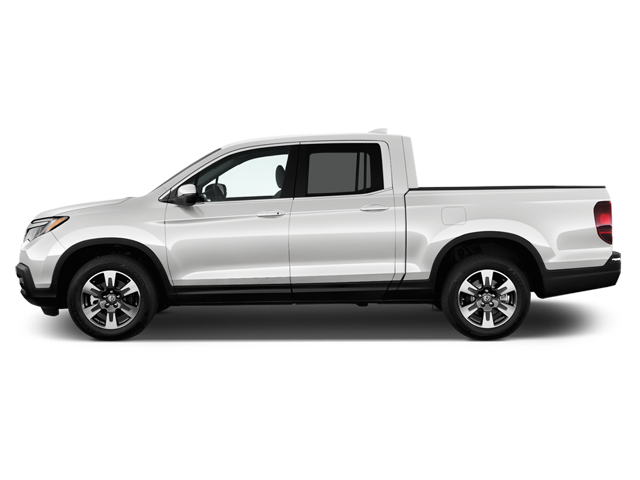The all-new, second-generation 2017 Honda Ridgeline pickup is fresh off the press, packs new features and tech, carries a whole new look, and is improved throughout. However, you still need to be realistic with your needs for a pickup in order for it to make a lot of sense.
Overbuying in the pickup truck segment is a national pastime. Most folks who need a little truck to tow a little stuff end up buying a big truck. And most folks who need to tow something a bit bigger decide to buy a heavy-duty. I have countless friends who drive trucks powered by honking-great V8 engines… so they can tow a small boat, twice a year. The rest of the time, they’re burning lots of fuel, taking up lots of space, and hauling groceries and golf clubs.
The Honda Ridgeline has a V6, not a V8. It’s built on a car-like unibody structure. The suspension is more crossover than pickup. There are no leaf springs. No solid rear axle. No low range. The cargo box is relatively small and shallow.
This isn’t a truck for the big-truck guys, who may jab you about your Ridgeline, often and vigorously. Instead, the Honda Ridgeline is a truck for the shopper concerned mainly with comfort, fuel economy, versatility, and high resale value―less about towing capacity, torque, or the ability to pull tree stumps from the earth’s crust.
The new look flaunts an athletic leanness that flies in the face of big, bloated pickups, and best of all, the Ridgeline no longer looks like the love-child of a Chevrolet Avalanche and a Cuisinart toaster oven.
The cabin looks big, and feels even bigger. The floor is smooth and lump-free, access requires little more than a slight tippy-toe hop-up for folks of average size, and even clumsy canines and mobility-challenged humans can board and exit with ease thanks to wide-opening doors and a low floor.
The rear quarters are extra-roomy, with seat bottoms that can be flipped upright to create a generous cargo hold or a lounge for your dog. Also, in typical Honda fashion, the cabin is peppered vigorously with storage cubbies that would make an IKEA closet organizer jealous. Supercharged 2.5-amp USB charging ports, which cram electrons into your power-sucking mobile devices, are a welcomed touch.
The new Ridgeline interior impresses more in terms of thoughtful touches, and less in terms of design. It’s dark, tidy, and logical, but lacks flair and excitement. Designers skipped creating a revolutionary new pickup cabin to ensure loyal Honda owners feel right at home.
In the back, the 2017 Honda Ridgeline’s shallow box still conceals a monster trunk beneath the rear portion of its floor, and said trunk is drainable, lockable, illuminated, and accessed via an enchanting tailgate that swings both ways (vertically or horizontally). Fill that trunk with ice and drinks, soggy kayak gear, sandy beach towels, or your coolers, then lock said stuff away, secure, and out of sight.
This second generation of the Ridgeline also offers a truck-bed audio system that uses exciters to turn the entire bed into an enormous plastic speaker. The sound is loud and clear, enabling tailgate parties or worksite tuneage, and playing Lamborghini acceleration noises through the outward-firing audio system as you drive away in traffic is always a laugh.
A 120V power outlet in the bed offers 400W, sufficient to power even high-draw appliances like a television or a smoothie blender for your tailgates.
On the other hand, the small and shallow box makes the big-truck guys wonder where you’d put your ATV. It’s handy first, size second, though flat-hauling of drywall panels is now possible after designers widened the bed to 5’.
Under the hood, a new 3.5L V6 runs direct injection and VTEC valve timing for 280 horsepower—an improvement over the original Ridgeline, with the increase felt mostly as added eagerness in low-rpm, light-throttle city driving. Hammer the throttle, and the new V6 pulls delightfully to max revs, emitting the classic VTEC snarl in the process. There’s a 6-speed automatic transmission, and towing capacity is rated at 5,000 lbs.
Around town, expect none of the rigid jiggle-jounce or leaf-springiness that’s characteristic of ladder-frame pickups. The 2017 Honda Ridgeline feels more planted on rougher roads, offers steering that’s crisper and more responsive, and parks more easily, too. Noise levels are kept in check during highway cruising, and the light but relatively precise steering facilitates a good attachment to the centre of your lane.
Overall, here’s a pickup that’s no more difficult to position or maneuver than a family sedan. Meanwhile, the brakes bite hard, build confidence, and are nearly sports-car precise.
Off-road driving on rough terrain is a mixed bag, though. On the plus side, the suspension travels abundantly, soaking up whumps and moguls with minimal tossing around of occupants. The steering is appreciably light during lower-speed off-road maneuvers, too. Problem is, as conditions get rougher, you’ll probably hear the front bumper: It hangs lower than anything beneath the Ridgeline, and on several occasions I wished for more clearance.
You’ll hear from the suspension, as well. The design that enables the Ridgeline’s car-like ride and handling trades away some feel of off-road durability, characteristic of bigger trucks, on craggier terrain. The suspension can become noisy and transmit more vibration and harshness back into the cabin when rough gravel, washboards or rocks pass beneath. Where a ladder-frame pickup feels more dense, more robust, quieter, and more durable in the rough, the 2017 Honda Ridgeline feels a few measures more delicate and noisier beneath you when the going gets extra-rough.
Electronic aids prove effective. Drivers can dial in one of several off-road modes, though left in “AUTO” the Ridgeline manages wheel-by-wheel traction expertly. Slight traction control interventions are apparent even as a wheel unloads while the Ridgeline pitches sideways or diagonally crosses a mogul—preemptively stopping slippage from an almost-airborne wheel before it starts.
But all in all, the biggest improvement from the driver’s seat is apparent on the road, not in the dirt. The operational refinement and the sense of a pickup truck that drives like a car are stronger and more finely honed now. The new Ridgeline is quieter, more comfortable, lighter on its feet, less cumbersome, and more eager to perform.
Gripes? The navigation and infotainment interface falls far behind most competitors for its display, responsiveness, and graphical horsepower. Also, for the money, some shoppers will expect a more exciting look to the cabin or perhaps a splash of colour to break up the darkness.
There is one other problem: The 2017 Honda Ridgeline is relatively pricey, with my Touring tester carrying a $47,000 sticker.
A common question from friends and family went something like this: “Why would I pay nearly fifty grand for this when the Ford / Ram / GM trucks are bigger, cost less, have a V8, and can tow heavier stuff?”
It’s a fair question, and one that a niche group of pickup shoppers will continue to answer with their dollars.
Road Tests and Reviews







